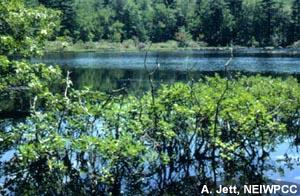Ponds and Open Water

Ponds and open water bodies may be large or small, deep or shallow, naturally occurring or man-made. Generally ponds are small and shallow and lakes are larger and deeper. Some may be permanently flooded, while others may occasionally be dry. Vegetation associated with ponds and open water bodies varies with the water depth. Along the shore, a fringe of emergent vegetation such as cattail (Typha sp.) or pickerelweed (Pontederia cordata) might be present. In deeper water, floating-leafed plants such as white and yellow water lilies (Nymphaea odorata and Nuphar) are common. Coontail (Ceratophyllum) and waterweed (Elodea) are examples of submergents; i.e., plants underneath the water's surface.

Beavers (Castor canadensis) are becoming more common residents of Rhode Island's wetlands. Beavers burrow their homes into the banks of rivers, or construct lodges in lakes and ponds.
Ponds and open water bodies are rich habitats for fish and wildlife. Painted turtles (Chrysemys picta) bask on sunny rocks and logs to regulate their body temperature; great blue herons (Ardea herodias) are stealth hunters that stalk bullfrogs along the waters edge; and tree swallows (Tachycineta bicolor) are acrobatic flyers that feed near the water's surface on emerging aquatic insects. Largemouth bass (Micropterus salmoides), which steadfastly guard their nests on a pond bottom, yellow perch (Perca flavescens) and pumpkinseed (Lepomis gibbosus) are all commonly found.
Additional Resources
- Guide to Under-standing Freshwater Aquatic Plants
- Stop Invasive Species Boat Ramp Sign
- Identification and Management of Aquatic Invasive Species
- Aquatic Invasive Species Map and List
